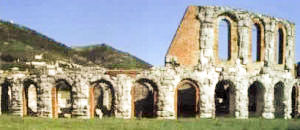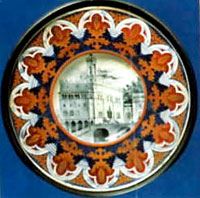Index | Assisi | Bevagna | Deruta | Montefalco | Orvieto | Perugia | Spello | Spoleto | Todi
 Gubbio is a worthwhile destination on any trip to Italy. It is an ancient and noble Italian city laid at the foot of Mt. Ingino with the beautiful Saonda river running just beneath it. The entire area is framed with undulating hills which provide a spectacular backdrop for this fascinating Italian locale.
Gubbio is a worthwhile destination on any trip to Italy. It is an ancient and noble Italian city laid at the foot of Mt. Ingino with the beautiful Saonda river running just beneath it. The entire area is framed with undulating hills which provide a spectacular backdrop for this fascinating Italian locale.
This small town is easy to explore on foot. The square at the base of the hill, Quaranta Martira provides ample parking from which the steep, but brief assent up Via della Republica takes you to the main square, Piazza Grande. The layout of the town center encompasses the characteristic features of a medieval center. Still enclosed in town walls, the medieval buildings and streets incorporate the widespread use of limestone giving the town a charming and characteristically timeless ambiance. Also included are magnificent examples of Renaissance architecture.
The ancient buildings surrounding the main Piazza are dominated by the 14th Century Palazzo dei Consoli which houses the Museo Civico. Here one can view the Eugubian Tables for which Gubbio is famous. These slates, dating from the 3rd century, constitute the best examples of ancient Umbrian script available. They also provide an important key to the understanding of the civilization of Italy and the structure of the city-state between 3and 1 BC.
 Discovered in the 15th Century underneath the Roman amphitheater, the Tablets describe ceremonies that took place in the ancient Italian city and provide a detailed description of the district. Through them it is know that the original settlement consisted of two separate communities located at different altitudes along the slope. The Romanization of the territory is portrayed as a peaceful and amicable episode in the city's history with Umbrian traditions maintained alongside the Roman laws and civil administrations.
Discovered in the 15th Century underneath the Roman amphitheater, the Tablets describe ceremonies that took place in the ancient Italian city and provide a detailed description of the district. Through them it is know that the original settlement consisted of two separate communities located at different altitudes along the slope. The Romanization of the territory is portrayed as a peaceful and amicable episode in the city's history with Umbrian traditions maintained alongside the Roman laws and civil administrations.
 Gubbio is a city of Italian culture and historical traditions, including interesting local Italian festivals. The Corsa dei Ceri, held in mid May, honors St. Ubaldo, the town's patron saint, for his apparent assistance in helping defeat rival communes. This celebration deserves special mention due to its religious and secular connotations and the aire of exuberance it incites. On the eve of the patron saints day, candle bearers carry enormous polygonal wooden towers, topped with the wax figure of a saint. They "race" to the finish with the understanding that Ubaldo must always arrive first. The celebration is also reputed to bring auspicious circumstances to the town at the advent of spring.
Gubbio is a city of Italian culture and historical traditions, including interesting local Italian festivals. The Corsa dei Ceri, held in mid May, honors St. Ubaldo, the town's patron saint, for his apparent assistance in helping defeat rival communes. This celebration deserves special mention due to its religious and secular connotations and the aire of exuberance it incites. On the eve of the patron saints day, candle bearers carry enormous polygonal wooden towers, topped with the wax figure of a saint. They "race" to the finish with the understanding that Ubaldo must always arrive first. The celebration is also reputed to bring auspicious circumstances to the town at the advent of spring.
Tourism , along with agriculture and local handcrafts are important factors in the economy. The production of handmade Italian ceramics also makes a significant contribution, together with wrought iron, woodworking and copperware.
The local fare incorporates the best of Italian cooking techniques and features wholesome, home-made dishes. The local white truffle is a frequent accompaniment to many dishes in the autumn and winter months.








